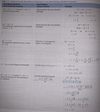Equations and Inequalities Flashcards
(56 cards)
Linear Equation

Generating Equivalent Equations

Solving a Linear Equation
- Simplify the algebraic expression on each side by removing grouping symbols and combining like terms.
- Collect all the variable terms on one side and all the numbers, or constant terms, on the other side.
- Isolate the variable and solve.
- Check the proposed solution in the orignal equation.
Rectangular Coordinate System (Cartesian Coordinate System)
Two number lines that intersect at right angles and their zero points.
X-Axis
The horizontal number line of the rectangular coordinate system.
Y-Axis
The vertical number line of the rectangular coordinate system
Origin
The point of intersection of the x-axis and the y-axis at their zero points
Quadrants
The division of the planes of the rectangular coordinate system into 4 quadrants.
- Upper Right
- Upper Left
- Lower Left
- Lower Right
Ordered Pair
A pair of real numbers that correspont to a point in the rectangular coordinate system. Written as ( x , y ).
x-coordinate
The first number of an ordered pair that denotes the distance and direction from the origin along the x-axis.
y-coordinate
The second number of an ordered pair that denotes the vertical distance and direction from the origin along the y-axis.
Plot
The points in the rectangular coordinate system that correspond to the location of an ordered pair.
x-intercept
The x-coordinate of a point where the graph intersects the x-axis
y-intercept
The y-coordinate of a point where the graph intersects the y-axis
Line Graphs
Used to illustrate trends over time
Linear Equation

Solving an Equation
The process of determining the values of the variables in an equation that result in a true statement when substituted into an equation.
Solution Set
The set of all solutions that satisfy an equation.
Equivalent Equations
Two or more equations that have the same solution set
Generating Equivelant Equations

Solving a Linear Equation
- Simplify the algebraic expression on each side by removing grouping symbols and combining like terms.
- Collect all the variable terms on one side and all the numbers or constant terms on the other side.
- Isolate the variable and solve.
- Check the proposed solution in the original equation.
Rational Equation
An equation containing one or more rational expressions.
Example - 1/x = 1/5 + 3/2x
Identity
An equation that is true for all real numbers for which both sides are defined.
Example - x + 3 = x + 2 + 1
Conditional Equation
An equation that is not an identity, but that is true for at least one real number

















